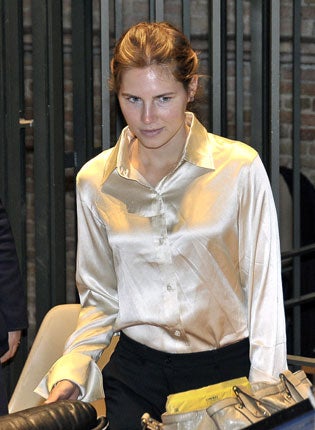Scientists cast doubt on evidence in Amanda Knox trial

Your support helps us to tell the story
From reproductive rights to climate change to Big Tech, The Independent is on the ground when the story is developing. Whether it's investigating the financials of Elon Musk's pro-Trump PAC or producing our latest documentary, 'The A Word', which shines a light on the American women fighting for reproductive rights, we know how important it is to parse out the facts from the messaging.
At such a critical moment in US history, we need reporters on the ground. Your donation allows us to keep sending journalists to speak to both sides of the story.
The Independent is trusted by Americans across the entire political spectrum. And unlike many other quality news outlets, we choose not to lock Americans out of our reporting and analysis with paywalls. We believe quality journalism should be available to everyone, paid for by those who can afford it.
Your support makes all the difference.Amanda Knox and her ex-boyfriend Raffaele Sollecito return to court in Perugia today for what could be a crucial turning point in their appeal against their convictions for murdering the English exchange student Meredith Kercher in November 2007.
There has never been any evidence placing Amanda Knox in the room where Ms Kercher was murdered. But at the original trial, the prosecution argued successfully that the DNA of Sollecito found on Ms Kercher's bra clasp at the scene and the victim's DNA found on the tip of a knife in Sollecito's flat proved the pair's involvement.
They said that the knife – identified, as the detective concerned told the original trial, by his "investigative intuition" – was the murder weapon. Taken together, they were deemed sufficient to prove the pair's involvement in the murder of the 21-year-old student from Coulsdon, Surrey, who was Knox's flatmate.
But a report filed by two of Italy's most eminent forensic scientists, which the court will begin considering today, rubbishes that evidence. The bra clasp was taken from the crime scene 46 days after the murder, and the defence has long argued that whatever evidence it bore was unreliable because of that lapse of time.
The new report confirms that claim, and says the alleged DNA on the knife is equally unreliable. The two forensic experts from La Sapienza University in Rome found that the forensic team in the original trial failed to follow correct procedures, both at the crime scene and subsequently in the laboratory. Now the appeal hearing will begin to consider the mass of new evidence presented over the past months. Closing arguments will begin on 5 September, and Judge Claudio Pratillo Hellman is expected to deliver his verdict before the end of September.
In the first trial, the public prosecutor, Giuliano Mignini, told the court that Knox, Sollecito and an African-born drifter, Rudy Guede, had ensnared Ms Kercher in a ritualistic sex game the night after Halloween in 2007. When Ms Kercher refused to take part in the orgy she was brutally stabbed to death, with Knox wielding the weapon.
This was the version of the crime that appalled and enthralled newspaper readers in Italy, Britain and beyond, and ensured a fascinated audience as the trial unfolded.
Knox and Sollecito have already spent nearly four years behind bars, and during the appeal. The strain of long incarceration has become apparent: at a hearing in May, Knox told the court, with tears streaming down her face: "I, an innocent person, have been in prison for three-and-a-half years."
Subscribe to Independent Premium to bookmark this article
Want to bookmark your favourite articles and stories to read or reference later? Start your Independent Premium subscription today.
Join our commenting forum
Join thought-provoking conversations, follow other Independent readers and see their replies
Comments